Dimello's Strategy for International Expansion: Market Analysis
VerifiedAdded on 2023/06/15
|18
|5630
|63
Report
AI Summary
This report examines Dimello Organisation's strategy for international expansion, focusing on tapping into new markets, particularly India. It analyses the global business environment and the influence of key drivers such as market, cost, and technology. The rationale for SMEs to expand business is explored, along with opportunities and threats in an increasingly competitive international market. The report also determines the benefits of global blocs and agreements and explains tariff and non-tariff barriers. Furthermore, it discusses how to start an exporting business, the benefits and drawbacks of importing and exporting, differences between merchandise and service trade, and various methods for SMEs to tap into global markets, providing a comprehensive overview of the considerations for Dimello's global expansion.
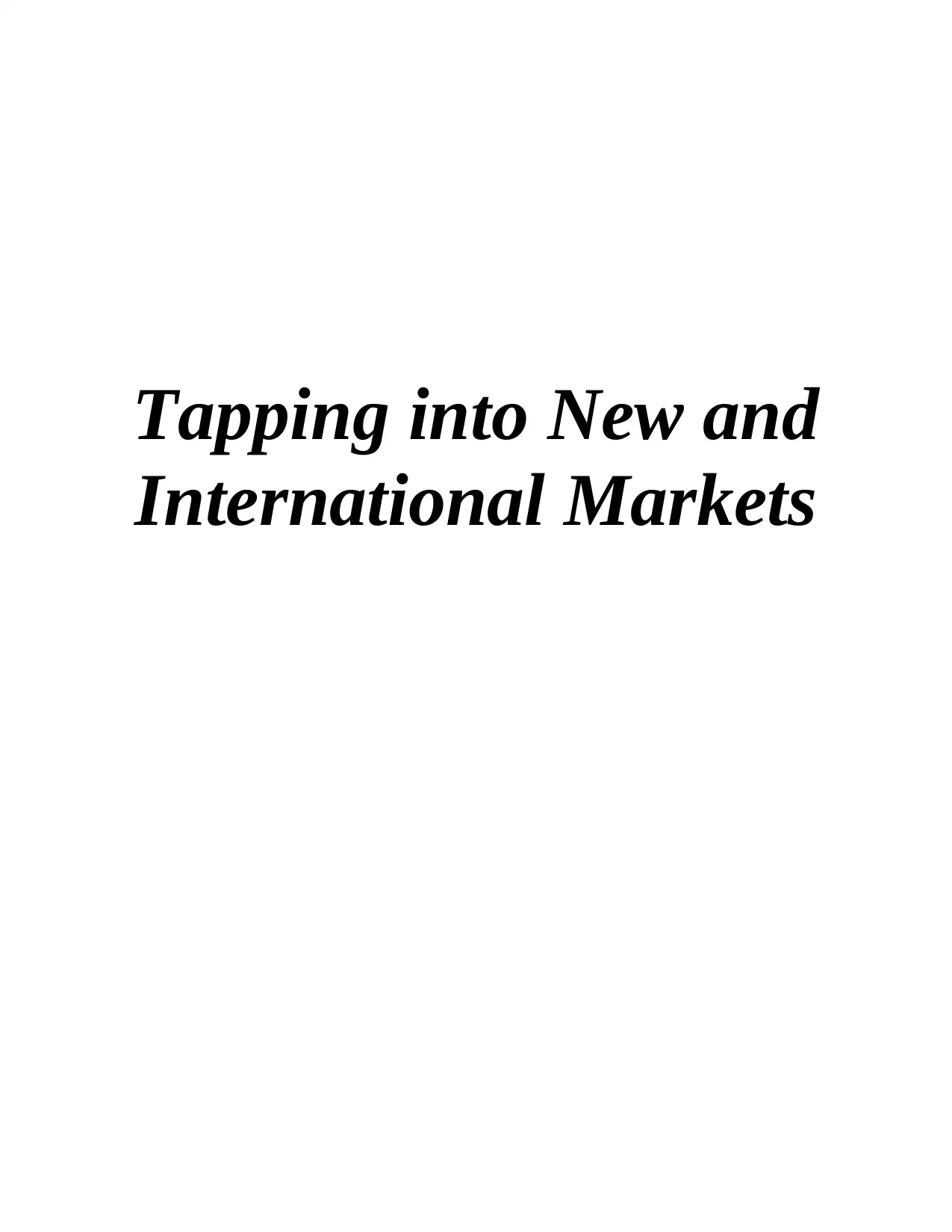
Tapping into New and
International Markets
International Markets
Paraphrase This Document
Need a fresh take? Get an instant paraphrase of this document with our AI Paraphraser
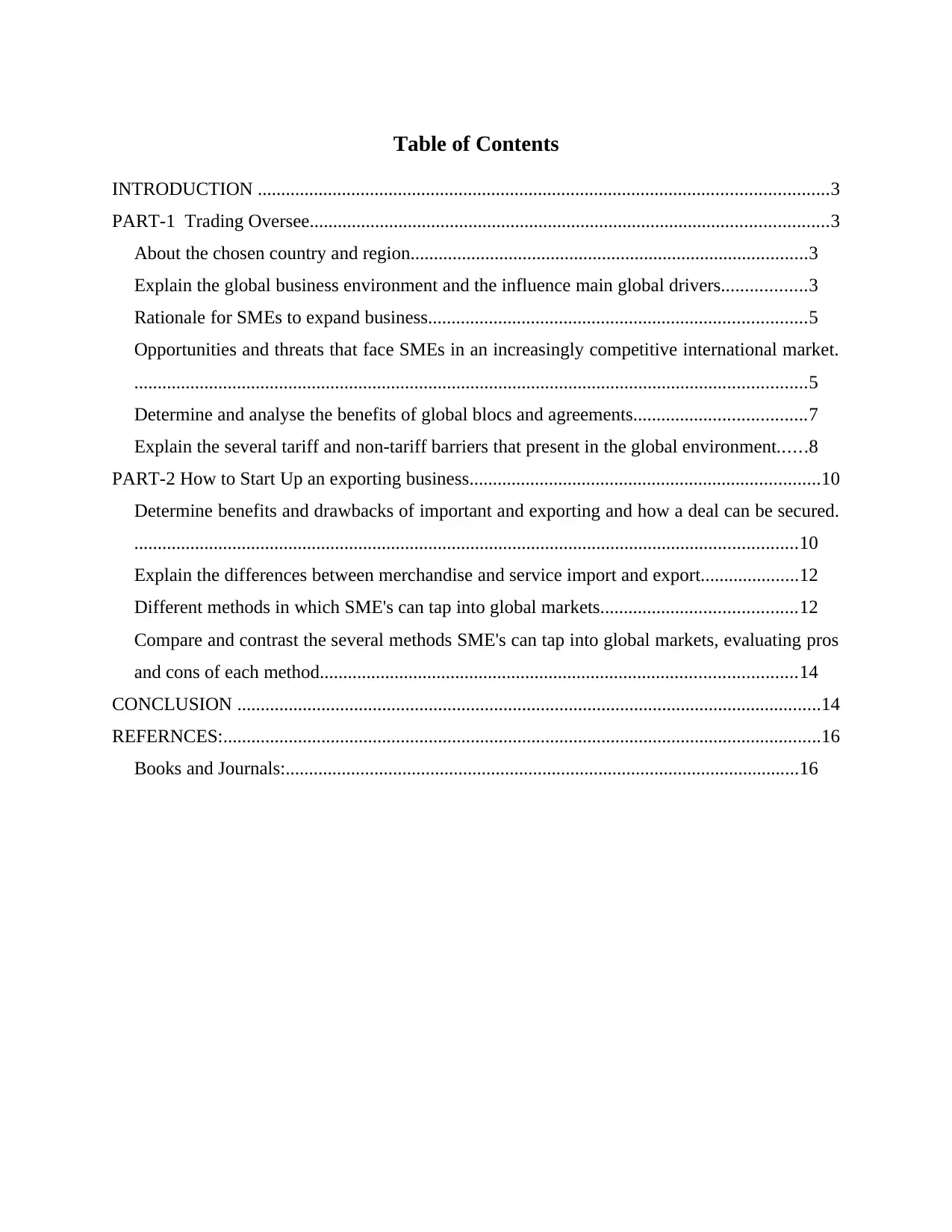
Table of Contents
INTRODUCTION ..........................................................................................................................3
PART-1 Trading Oversee...............................................................................................................3
About the chosen country and region.....................................................................................3
Explain the global business environment and the influence main global drivers..................3
Rationale for SMEs to expand business.................................................................................5
Opportunities and threats that face SMEs in an increasingly competitive international market.
................................................................................................................................................5
Determine and analyse the benefits of global blocs and agreements.....................................7
Explain the several tariff and non-tariff barriers that present in the global environment......8
PART-2 How to Start Up an exporting business...........................................................................10
Determine benefits and drawbacks of important and exporting and how a deal can be secured.
..............................................................................................................................................10
Explain the differences between merchandise and service import and export.....................12
Different methods in which SME's can tap into global markets..........................................12
Compare and contrast the several methods SME's can tap into global markets, evaluating pros
and cons of each method......................................................................................................14
CONCLUSION .............................................................................................................................14
REFERNCES:................................................................................................................................16
Books and Journals:..............................................................................................................16
INTRODUCTION ..........................................................................................................................3
PART-1 Trading Oversee...............................................................................................................3
About the chosen country and region.....................................................................................3
Explain the global business environment and the influence main global drivers..................3
Rationale for SMEs to expand business.................................................................................5
Opportunities and threats that face SMEs in an increasingly competitive international market.
................................................................................................................................................5
Determine and analyse the benefits of global blocs and agreements.....................................7
Explain the several tariff and non-tariff barriers that present in the global environment......8
PART-2 How to Start Up an exporting business...........................................................................10
Determine benefits and drawbacks of important and exporting and how a deal can be secured.
..............................................................................................................................................10
Explain the differences between merchandise and service import and export.....................12
Different methods in which SME's can tap into global markets..........................................12
Compare and contrast the several methods SME's can tap into global markets, evaluating pros
and cons of each method......................................................................................................14
CONCLUSION .............................................................................................................................14
REFERNCES:................................................................................................................................16
Books and Journals:..............................................................................................................16

⊘ This is a preview!⊘
Do you want full access?
Subscribe today to unlock all pages.

Trusted by 1+ million students worldwide
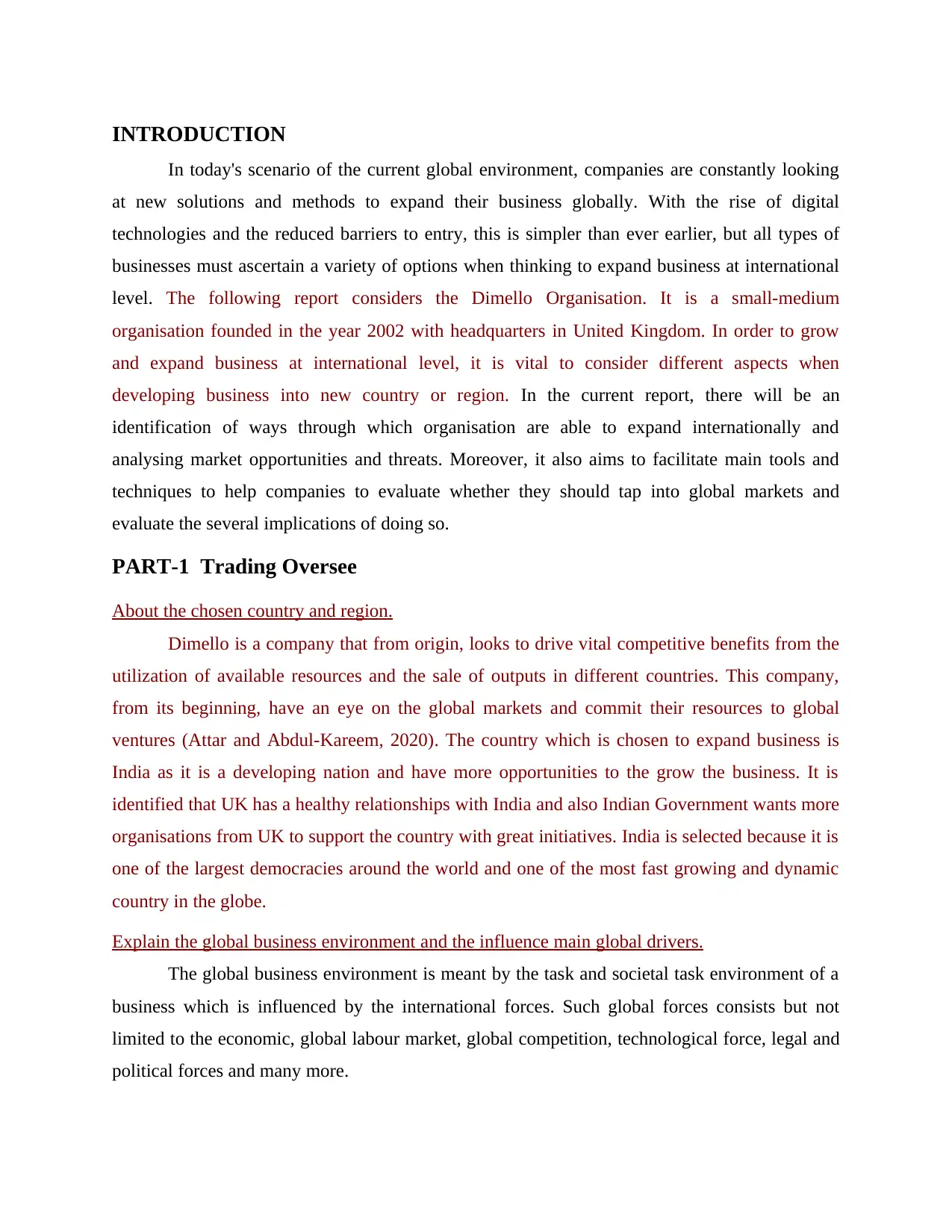
INTRODUCTION
In today's scenario of the current global environment, companies are constantly looking
at new solutions and methods to expand their business globally. With the rise of digital
technologies and the reduced barriers to entry, this is simpler than ever earlier, but all types of
businesses must ascertain a variety of options when thinking to expand business at international
level. The following report considers the Dimello Organisation. It is a small-medium
organisation founded in the year 2002 with headquarters in United Kingdom. In order to grow
and expand business at international level, it is vital to consider different aspects when
developing business into new country or region. In the current report, there will be an
identification of ways through which organisation are able to expand internationally and
analysing market opportunities and threats. Moreover, it also aims to facilitate main tools and
techniques to help companies to evaluate whether they should tap into global markets and
evaluate the several implications of doing so.
PART-1 Trading Oversee
About the chosen country and region.
Dimello is a company that from origin, looks to drive vital competitive benefits from the
utilization of available resources and the sale of outputs in different countries. This company,
from its beginning, have an eye on the global markets and commit their resources to global
ventures (Attar and Abdul-Kareem, 2020). The country which is chosen to expand business is
India as it is a developing nation and have more opportunities to the grow the business. It is
identified that UK has a healthy relationships with India and also Indian Government wants more
organisations from UK to support the country with great initiatives. India is selected because it is
one of the largest democracies around the world and one of the most fast growing and dynamic
country in the globe.
Explain the global business environment and the influence main global drivers.
The global business environment is meant by the task and societal task environment of a
business which is influenced by the international forces. Such global forces consists but not
limited to the economic, global labour market, global competition, technological force, legal and
political forces and many more.
In today's scenario of the current global environment, companies are constantly looking
at new solutions and methods to expand their business globally. With the rise of digital
technologies and the reduced barriers to entry, this is simpler than ever earlier, but all types of
businesses must ascertain a variety of options when thinking to expand business at international
level. The following report considers the Dimello Organisation. It is a small-medium
organisation founded in the year 2002 with headquarters in United Kingdom. In order to grow
and expand business at international level, it is vital to consider different aspects when
developing business into new country or region. In the current report, there will be an
identification of ways through which organisation are able to expand internationally and
analysing market opportunities and threats. Moreover, it also aims to facilitate main tools and
techniques to help companies to evaluate whether they should tap into global markets and
evaluate the several implications of doing so.
PART-1 Trading Oversee
About the chosen country and region.
Dimello is a company that from origin, looks to drive vital competitive benefits from the
utilization of available resources and the sale of outputs in different countries. This company,
from its beginning, have an eye on the global markets and commit their resources to global
ventures (Attar and Abdul-Kareem, 2020). The country which is chosen to expand business is
India as it is a developing nation and have more opportunities to the grow the business. It is
identified that UK has a healthy relationships with India and also Indian Government wants more
organisations from UK to support the country with great initiatives. India is selected because it is
one of the largest democracies around the world and one of the most fast growing and dynamic
country in the globe.
Explain the global business environment and the influence main global drivers.
The global business environment is meant by the task and societal task environment of a
business which is influenced by the international forces. Such global forces consists but not
limited to the economic, global labour market, global competition, technological force, legal and
political forces and many more.
Paraphrase This Document
Need a fresh take? Get an instant paraphrase of this document with our AI Paraphraser
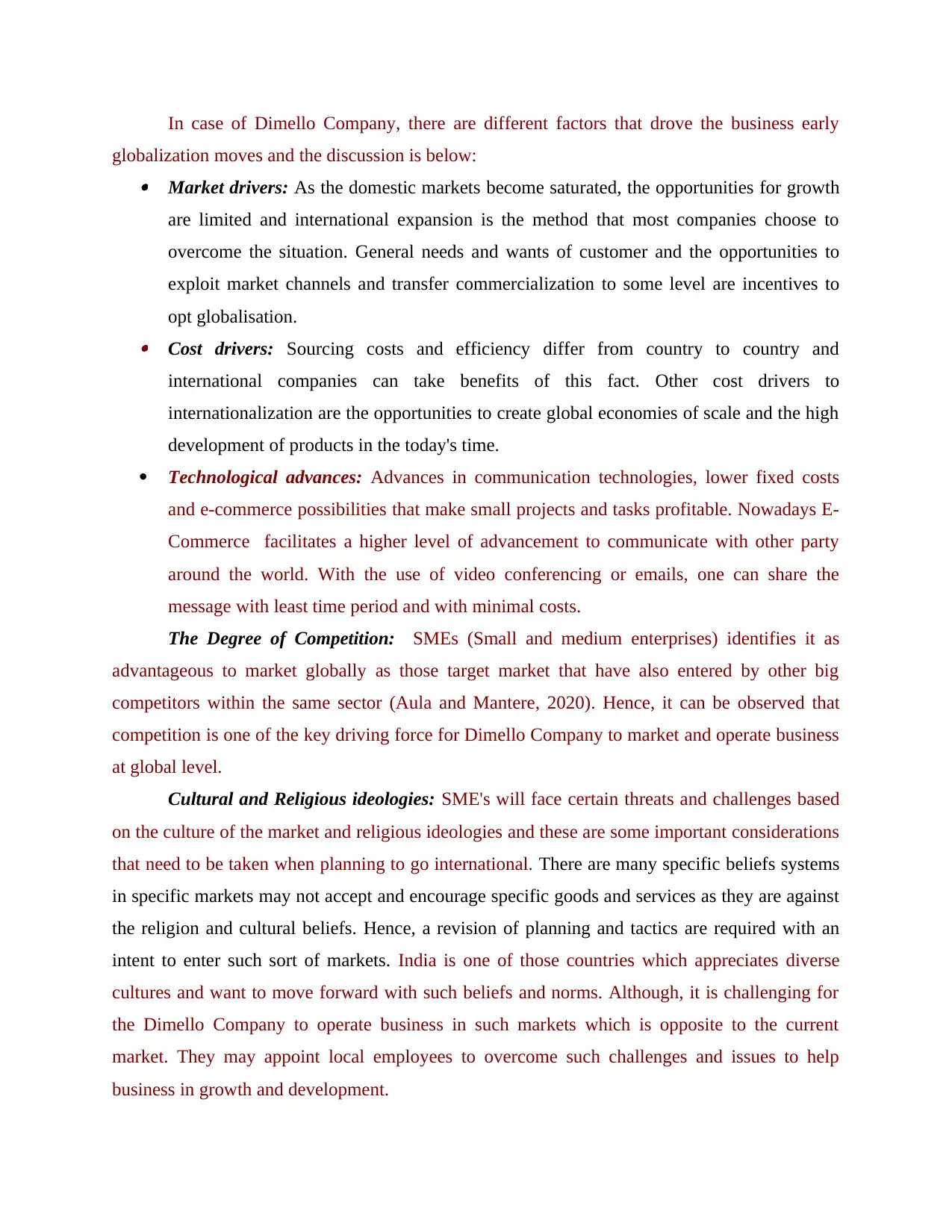
In case of Dimello Company, there are different factors that drove the business early
globalization moves and the discussion is below: Market drivers: As the domestic markets become saturated, the opportunities for growth
are limited and international expansion is the method that most companies choose to
overcome the situation. General needs and wants of customer and the opportunities to
exploit market channels and transfer commercialization to some level are incentives to
opt globalisation. Cost drivers: Sourcing costs and efficiency differ from country to country and
international companies can take benefits of this fact. Other cost drivers to
internationalization are the opportunities to create global economies of scale and the high
development of products in the today's time.
Technological advances: Advances in communication technologies, lower fixed costs
and e-commerce possibilities that make small projects and tasks profitable. Nowadays E-
Commerce facilitates a higher level of advancement to communicate with other party
around the world. With the use of video conferencing or emails, one can share the
message with least time period and with minimal costs.
The Degree of Competition: SMEs (Small and medium enterprises) identifies it as
advantageous to market globally as those target market that have also entered by other big
competitors within the same sector (Aula and Mantere, 2020). Hence, it can be observed that
competition is one of the key driving force for Dimello Company to market and operate business
at global level.
Cultural and Religious ideologies: SME's will face certain threats and challenges based
on the culture of the market and religious ideologies and these are some important considerations
that need to be taken when planning to go international. There are many specific beliefs systems
in specific markets may not accept and encourage specific goods and services as they are against
the religion and cultural beliefs. Hence, a revision of planning and tactics are required with an
intent to enter such sort of markets. India is one of those countries which appreciates diverse
cultures and want to move forward with such beliefs and norms. Although, it is challenging for
the Dimello Company to operate business in such markets which is opposite to the current
market. They may appoint local employees to overcome such challenges and issues to help
business in growth and development.
globalization moves and the discussion is below: Market drivers: As the domestic markets become saturated, the opportunities for growth
are limited and international expansion is the method that most companies choose to
overcome the situation. General needs and wants of customer and the opportunities to
exploit market channels and transfer commercialization to some level are incentives to
opt globalisation. Cost drivers: Sourcing costs and efficiency differ from country to country and
international companies can take benefits of this fact. Other cost drivers to
internationalization are the opportunities to create global economies of scale and the high
development of products in the today's time.
Technological advances: Advances in communication technologies, lower fixed costs
and e-commerce possibilities that make small projects and tasks profitable. Nowadays E-
Commerce facilitates a higher level of advancement to communicate with other party
around the world. With the use of video conferencing or emails, one can share the
message with least time period and with minimal costs.
The Degree of Competition: SMEs (Small and medium enterprises) identifies it as
advantageous to market globally as those target market that have also entered by other big
competitors within the same sector (Aula and Mantere, 2020). Hence, it can be observed that
competition is one of the key driving force for Dimello Company to market and operate business
at global level.
Cultural and Religious ideologies: SME's will face certain threats and challenges based
on the culture of the market and religious ideologies and these are some important considerations
that need to be taken when planning to go international. There are many specific beliefs systems
in specific markets may not accept and encourage specific goods and services as they are against
the religion and cultural beliefs. Hence, a revision of planning and tactics are required with an
intent to enter such sort of markets. India is one of those countries which appreciates diverse
cultures and want to move forward with such beliefs and norms. Although, it is challenging for
the Dimello Company to operate business in such markets which is opposite to the current
market. They may appoint local employees to overcome such challenges and issues to help
business in growth and development.
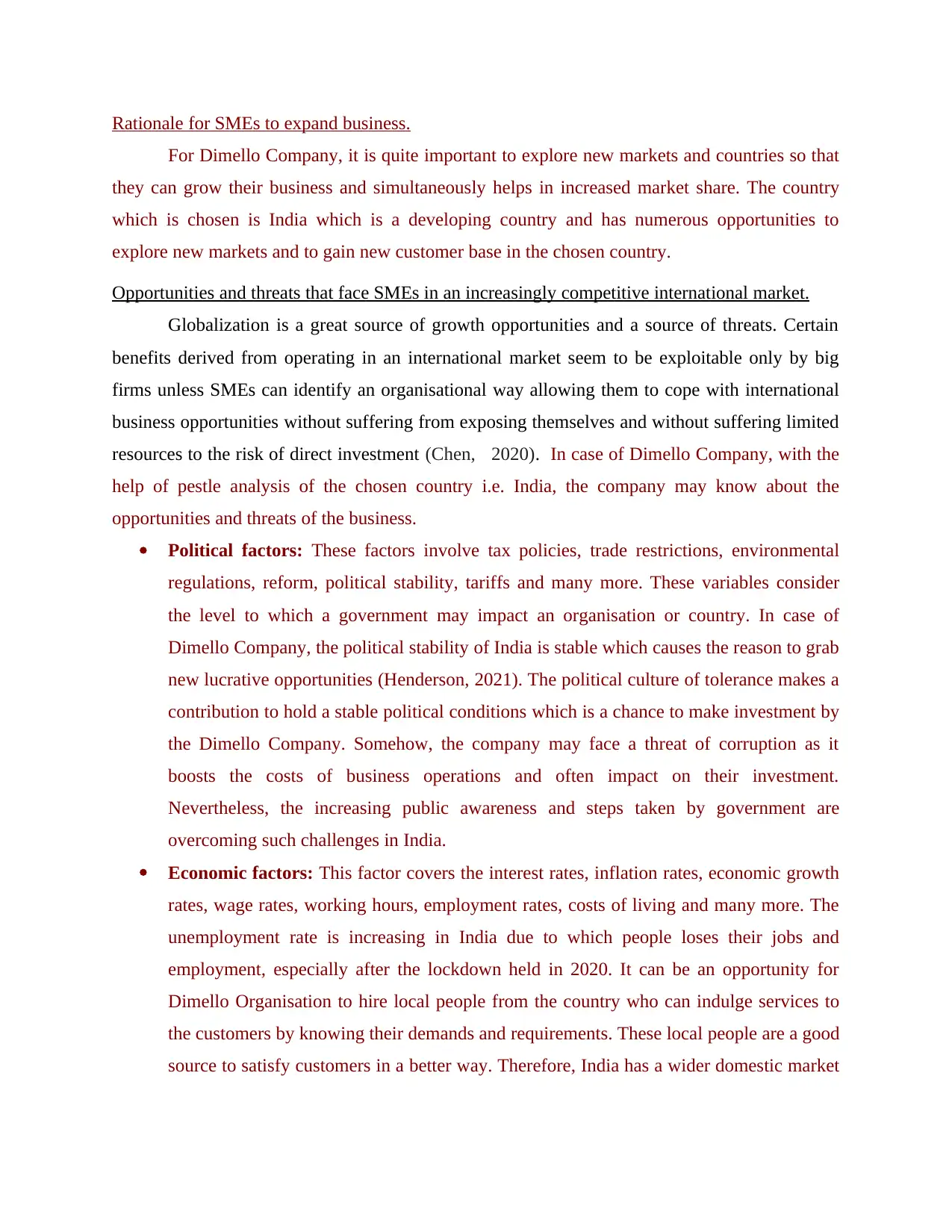
Rationale for SMEs to expand business.
For Dimello Company, it is quite important to explore new markets and countries so that
they can grow their business and simultaneously helps in increased market share. The country
which is chosen is India which is a developing country and has numerous opportunities to
explore new markets and to gain new customer base in the chosen country.
Opportunities and threats that face SMEs in an increasingly competitive international market.
Globalization is a great source of growth opportunities and a source of threats. Certain
benefits derived from operating in an international market seem to be exploitable only by big
firms unless SMEs can identify an organisational way allowing them to cope with international
business opportunities without suffering from exposing themselves and without suffering limited
resources to the risk of direct investment (Chen, 2020). In case of Dimello Company, with the
help of pestle analysis of the chosen country i.e. India, the company may know about the
opportunities and threats of the business.
Political factors: These factors involve tax policies, trade restrictions, environmental
regulations, reform, political stability, tariffs and many more. These variables consider
the level to which a government may impact an organisation or country. In case of
Dimello Company, the political stability of India is stable which causes the reason to grab
new lucrative opportunities (Henderson, 2021). The political culture of tolerance makes a
contribution to hold a stable political conditions which is a chance to make investment by
the Dimello Company. Somehow, the company may face a threat of corruption as it
boosts the costs of business operations and often impact on their investment.
Nevertheless, the increasing public awareness and steps taken by government are
overcoming such challenges in India.
Economic factors: This factor covers the interest rates, inflation rates, economic growth
rates, wage rates, working hours, employment rates, costs of living and many more. The
unemployment rate is increasing in India due to which people loses their jobs and
employment, especially after the lockdown held in 2020. It can be an opportunity for
Dimello Organisation to hire local people from the country who can indulge services to
the customers by knowing their demands and requirements. These local people are a good
source to satisfy customers in a better way. Therefore, India has a wider domestic market
For Dimello Company, it is quite important to explore new markets and countries so that
they can grow their business and simultaneously helps in increased market share. The country
which is chosen is India which is a developing country and has numerous opportunities to
explore new markets and to gain new customer base in the chosen country.
Opportunities and threats that face SMEs in an increasingly competitive international market.
Globalization is a great source of growth opportunities and a source of threats. Certain
benefits derived from operating in an international market seem to be exploitable only by big
firms unless SMEs can identify an organisational way allowing them to cope with international
business opportunities without suffering from exposing themselves and without suffering limited
resources to the risk of direct investment (Chen, 2020). In case of Dimello Company, with the
help of pestle analysis of the chosen country i.e. India, the company may know about the
opportunities and threats of the business.
Political factors: These factors involve tax policies, trade restrictions, environmental
regulations, reform, political stability, tariffs and many more. These variables consider
the level to which a government may impact an organisation or country. In case of
Dimello Company, the political stability of India is stable which causes the reason to grab
new lucrative opportunities (Henderson, 2021). The political culture of tolerance makes a
contribution to hold a stable political conditions which is a chance to make investment by
the Dimello Company. Somehow, the company may face a threat of corruption as it
boosts the costs of business operations and often impact on their investment.
Nevertheless, the increasing public awareness and steps taken by government are
overcoming such challenges in India.
Economic factors: This factor covers the interest rates, inflation rates, economic growth
rates, wage rates, working hours, employment rates, costs of living and many more. The
unemployment rate is increasing in India due to which people loses their jobs and
employment, especially after the lockdown held in 2020. It can be an opportunity for
Dimello Organisation to hire local people from the country who can indulge services to
the customers by knowing their demands and requirements. These local people are a good
source to satisfy customers in a better way. Therefore, India has a wider domestic market
⊘ This is a preview!⊘
Do you want full access?
Subscribe today to unlock all pages.

Trusted by 1+ million students worldwide
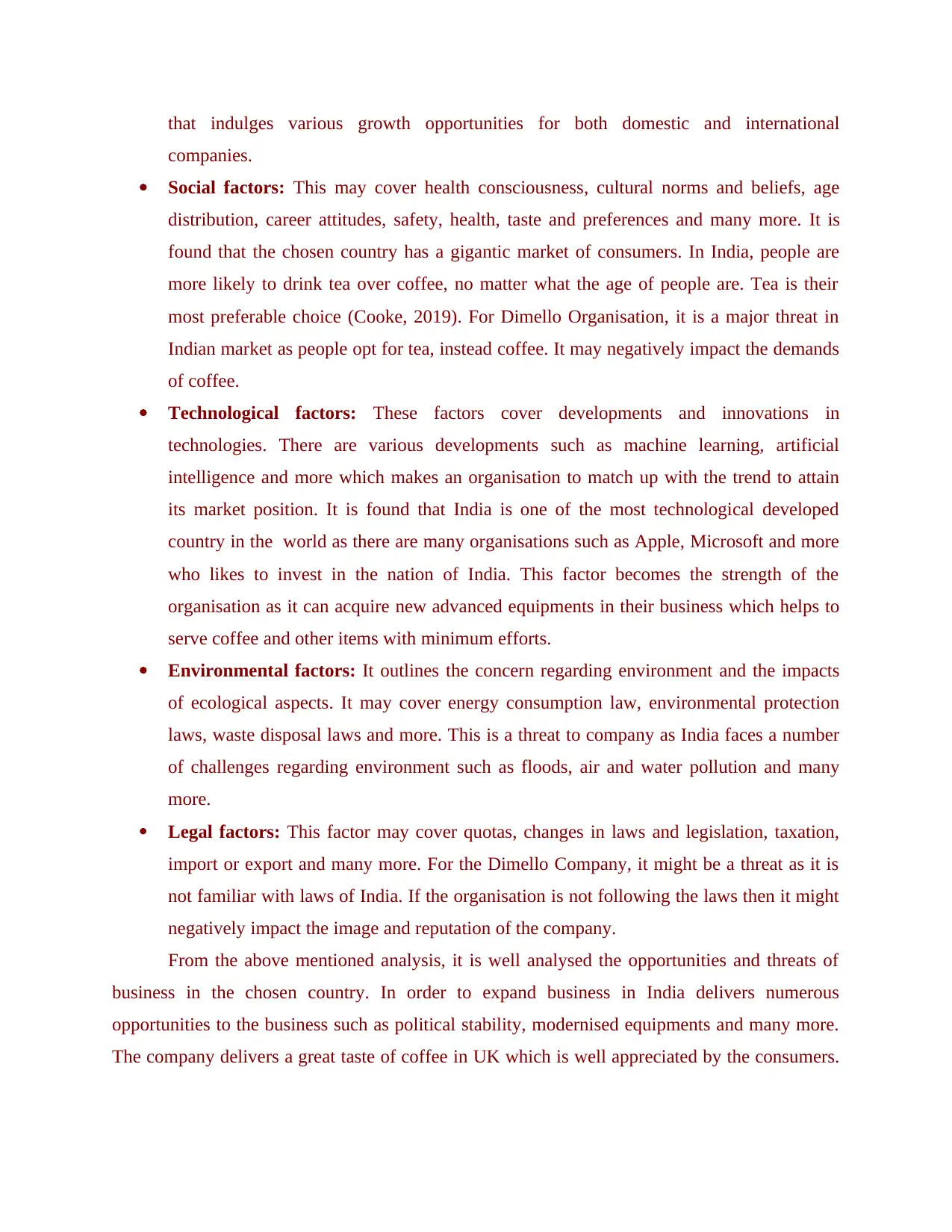
that indulges various growth opportunities for both domestic and international
companies.
Social factors: This may cover health consciousness, cultural norms and beliefs, age
distribution, career attitudes, safety, health, taste and preferences and many more. It is
found that the chosen country has a gigantic market of consumers. In India, people are
more likely to drink tea over coffee, no matter what the age of people are. Tea is their
most preferable choice (Cooke, 2019). For Dimello Organisation, it is a major threat in
Indian market as people opt for tea, instead coffee. It may negatively impact the demands
of coffee.
Technological factors: These factors cover developments and innovations in
technologies. There are various developments such as machine learning, artificial
intelligence and more which makes an organisation to match up with the trend to attain
its market position. It is found that India is one of the most technological developed
country in the world as there are many organisations such as Apple, Microsoft and more
who likes to invest in the nation of India. This factor becomes the strength of the
organisation as it can acquire new advanced equipments in their business which helps to
serve coffee and other items with minimum efforts.
Environmental factors: It outlines the concern regarding environment and the impacts
of ecological aspects. It may cover energy consumption law, environmental protection
laws, waste disposal laws and more. This is a threat to company as India faces a number
of challenges regarding environment such as floods, air and water pollution and many
more.
Legal factors: This factor may cover quotas, changes in laws and legislation, taxation,
import or export and many more. For the Dimello Company, it might be a threat as it is
not familiar with laws of India. If the organisation is not following the laws then it might
negatively impact the image and reputation of the company.
From the above mentioned analysis, it is well analysed the opportunities and threats of
business in the chosen country. In order to expand business in India delivers numerous
opportunities to the business such as political stability, modernised equipments and many more.
The company delivers a great taste of coffee in UK which is well appreciated by the consumers.
companies.
Social factors: This may cover health consciousness, cultural norms and beliefs, age
distribution, career attitudes, safety, health, taste and preferences and many more. It is
found that the chosen country has a gigantic market of consumers. In India, people are
more likely to drink tea over coffee, no matter what the age of people are. Tea is their
most preferable choice (Cooke, 2019). For Dimello Organisation, it is a major threat in
Indian market as people opt for tea, instead coffee. It may negatively impact the demands
of coffee.
Technological factors: These factors cover developments and innovations in
technologies. There are various developments such as machine learning, artificial
intelligence and more which makes an organisation to match up with the trend to attain
its market position. It is found that India is one of the most technological developed
country in the world as there are many organisations such as Apple, Microsoft and more
who likes to invest in the nation of India. This factor becomes the strength of the
organisation as it can acquire new advanced equipments in their business which helps to
serve coffee and other items with minimum efforts.
Environmental factors: It outlines the concern regarding environment and the impacts
of ecological aspects. It may cover energy consumption law, environmental protection
laws, waste disposal laws and more. This is a threat to company as India faces a number
of challenges regarding environment such as floods, air and water pollution and many
more.
Legal factors: This factor may cover quotas, changes in laws and legislation, taxation,
import or export and many more. For the Dimello Company, it might be a threat as it is
not familiar with laws of India. If the organisation is not following the laws then it might
negatively impact the image and reputation of the company.
From the above mentioned analysis, it is well analysed the opportunities and threats of
business in the chosen country. In order to expand business in India delivers numerous
opportunities to the business such as political stability, modernised equipments and many more.
The company delivers a great taste of coffee in UK which is well appreciated by the consumers.
Paraphrase This Document
Need a fresh take? Get an instant paraphrase of this document with our AI Paraphraser
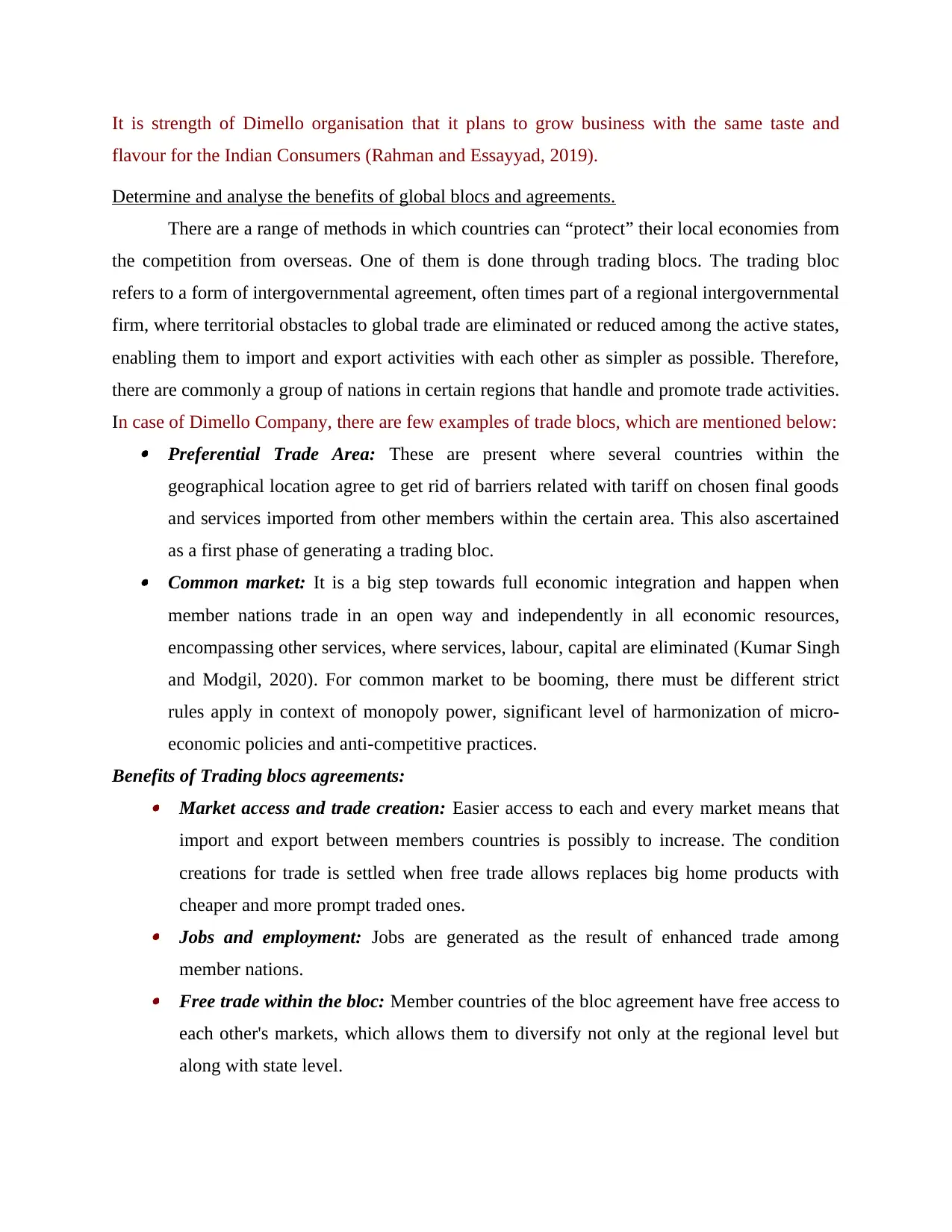
It is strength of Dimello organisation that it plans to grow business with the same taste and
flavour for the Indian Consumers (Rahman and Essayyad, 2019).
Determine and analyse the benefits of global blocs and agreements.
There are a range of methods in which countries can “protect” their local economies from
the competition from overseas. One of them is done through trading blocs. The trading bloc
refers to a form of intergovernmental agreement, often times part of a regional intergovernmental
firm, where territorial obstacles to global trade are eliminated or reduced among the active states,
enabling them to import and export activities with each other as simpler as possible. Therefore,
there are commonly a group of nations in certain regions that handle and promote trade activities.
In case of Dimello Company, there are few examples of trade blocs, which are mentioned below: Preferential Trade Area: These are present where several countries within the
geographical location agree to get rid of barriers related with tariff on chosen final goods
and services imported from other members within the certain area. This also ascertained
as a first phase of generating a trading bloc. Common market: It is a big step towards full economic integration and happen when
member nations trade in an open way and independently in all economic resources,
encompassing other services, where services, labour, capital are eliminated (Kumar Singh
and Modgil, 2020). For common market to be booming, there must be different strict
rules apply in context of monopoly power, significant level of harmonization of micro-
economic policies and anti-competitive practices.
Benefits of Trading blocs agreements: Market access and trade creation: Easier access to each and every market means that
import and export between members countries is possibly to increase. The condition
creations for trade is settled when free trade allows replaces big home products with
cheaper and more prompt traded ones. Jobs and employment: Jobs are generated as the result of enhanced trade among
member nations. Free trade within the bloc: Member countries of the bloc agreement have free access to
each other's markets, which allows them to diversify not only at the regional level but
along with state level.
flavour for the Indian Consumers (Rahman and Essayyad, 2019).
Determine and analyse the benefits of global blocs and agreements.
There are a range of methods in which countries can “protect” their local economies from
the competition from overseas. One of them is done through trading blocs. The trading bloc
refers to a form of intergovernmental agreement, often times part of a regional intergovernmental
firm, where territorial obstacles to global trade are eliminated or reduced among the active states,
enabling them to import and export activities with each other as simpler as possible. Therefore,
there are commonly a group of nations in certain regions that handle and promote trade activities.
In case of Dimello Company, there are few examples of trade blocs, which are mentioned below: Preferential Trade Area: These are present where several countries within the
geographical location agree to get rid of barriers related with tariff on chosen final goods
and services imported from other members within the certain area. This also ascertained
as a first phase of generating a trading bloc. Common market: It is a big step towards full economic integration and happen when
member nations trade in an open way and independently in all economic resources,
encompassing other services, where services, labour, capital are eliminated (Kumar Singh
and Modgil, 2020). For common market to be booming, there must be different strict
rules apply in context of monopoly power, significant level of harmonization of micro-
economic policies and anti-competitive practices.
Benefits of Trading blocs agreements: Market access and trade creation: Easier access to each and every market means that
import and export between members countries is possibly to increase. The condition
creations for trade is settled when free trade allows replaces big home products with
cheaper and more prompt traded ones. Jobs and employment: Jobs are generated as the result of enhanced trade among
member nations. Free trade within the bloc: Member countries of the bloc agreement have free access to
each other's markets, which allows them to diversify not only at the regional level but
along with state level.

Foreign direct investment: A rise in foreign direct investment results from trade blocs
agreements and serves goodness to the economies of the active member nations. This
results in bigger markets where services are being created locally at lower costs.
It has been evaluated the trading blocs are used by the countries to minimise the
competition overseas and around the world. There are range of trade blocs that are used by the
countries so that flows of goods and products can be enhanced and helps in the development of
countries in which business operates. For Dimello Company, there are huge benefits to explore
new markets such as they can gain number of new markers and customers to serve.
Simultaneously, it also supports the country in which business is operating with range of options
such as Foreign direct investment, jobs and employment and many more.
Comparative Advantage Theory-
Comparative advantage happens when a nation manufactures a product or any services
for a reduced opportunity cost than other nations. The cost of opportunity evaluates the trade-off.
A country which has comparative benefits creates a trade-off worthwhile. There is a chance that
nation may not be great at manufacturing something, but the items and commodities has a benefit
of low cost for other nations to import (Cui and et.al., 2021). For Dimello organisation, it can
generate low cost opportunities from the Indian market as they can take raw materials at very
low costs. It helps in making profits for the business by reducing the costs of flowing goods from
one country to another.
Explain the several tariff and non-tariff barriers that present in the global environment.
Tariff barriers:
Tariffs is simply meant by the custom duties on goods and services. It facilitates a price
benefit to domestic manufactured products over similar products which are traded, and they
increase the profits and revenues for the governments. Yet, tariffs are also imposed on exports of
goods and services. In context of Dimello Company, the following are the types of tariffs that
present in the international market: Revenue tariff: It is a most effective way to generate funds and revenues for the
government. For instance, tariffs can be imposed on such goods and services where
certain goods or services cannot be available and therefore, tariff on that import will
increase the revenue flow for governments.
agreements and serves goodness to the economies of the active member nations. This
results in bigger markets where services are being created locally at lower costs.
It has been evaluated the trading blocs are used by the countries to minimise the
competition overseas and around the world. There are range of trade blocs that are used by the
countries so that flows of goods and products can be enhanced and helps in the development of
countries in which business operates. For Dimello Company, there are huge benefits to explore
new markets such as they can gain number of new markers and customers to serve.
Simultaneously, it also supports the country in which business is operating with range of options
such as Foreign direct investment, jobs and employment and many more.
Comparative Advantage Theory-
Comparative advantage happens when a nation manufactures a product or any services
for a reduced opportunity cost than other nations. The cost of opportunity evaluates the trade-off.
A country which has comparative benefits creates a trade-off worthwhile. There is a chance that
nation may not be great at manufacturing something, but the items and commodities has a benefit
of low cost for other nations to import (Cui and et.al., 2021). For Dimello organisation, it can
generate low cost opportunities from the Indian market as they can take raw materials at very
low costs. It helps in making profits for the business by reducing the costs of flowing goods from
one country to another.
Explain the several tariff and non-tariff barriers that present in the global environment.
Tariff barriers:
Tariffs is simply meant by the custom duties on goods and services. It facilitates a price
benefit to domestic manufactured products over similar products which are traded, and they
increase the profits and revenues for the governments. Yet, tariffs are also imposed on exports of
goods and services. In context of Dimello Company, the following are the types of tariffs that
present in the international market: Revenue tariff: It is a most effective way to generate funds and revenues for the
government. For instance, tariffs can be imposed on such goods and services where
certain goods or services cannot be available and therefore, tariff on that import will
increase the revenue flow for governments.
⊘ This is a preview!⊘
Do you want full access?
Subscribe today to unlock all pages.

Trusted by 1+ million students worldwide
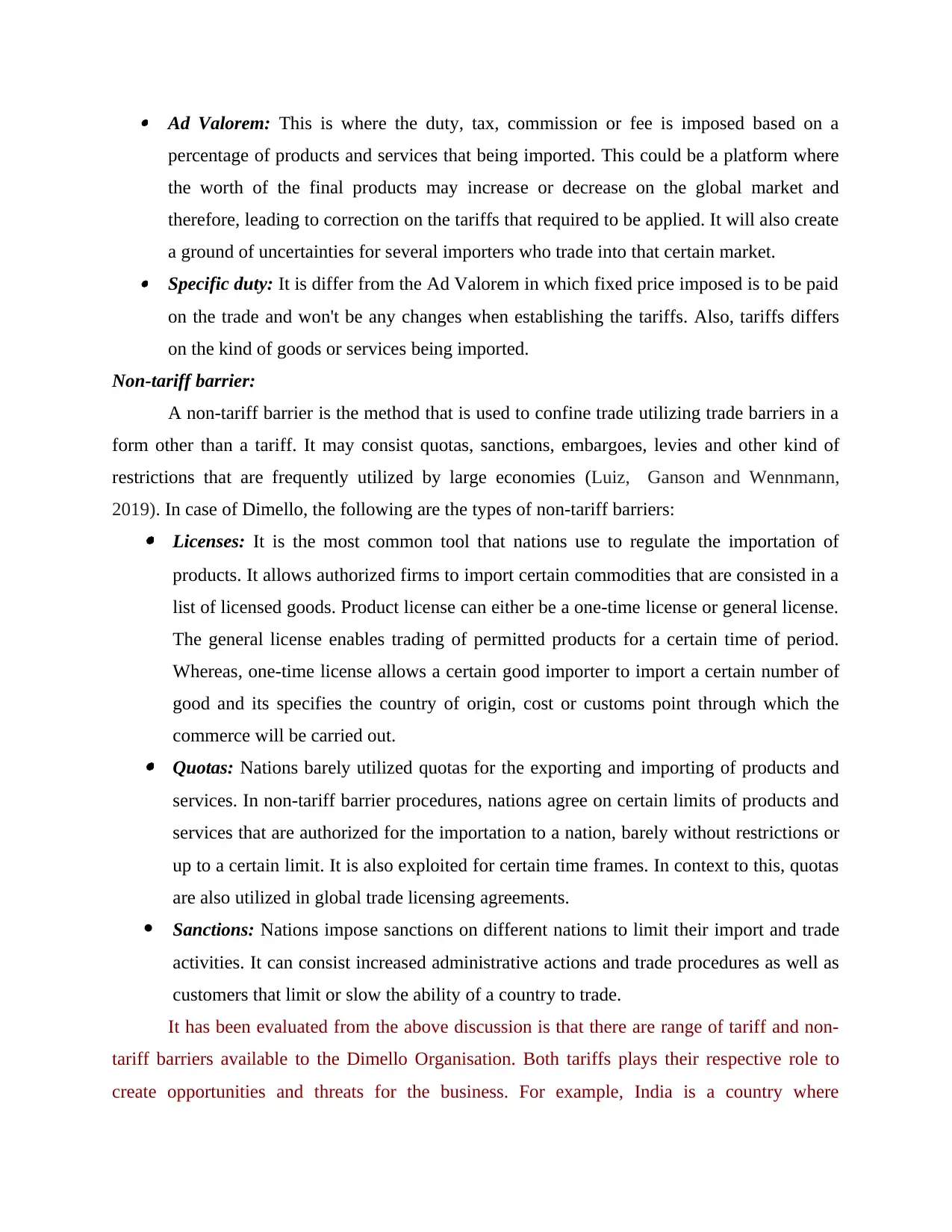
Ad Valorem: This is where the duty, tax, commission or fee is imposed based on a
percentage of products and services that being imported. This could be a platform where
the worth of the final products may increase or decrease on the global market and
therefore, leading to correction on the tariffs that required to be applied. It will also create
a ground of uncertainties for several importers who trade into that certain market. Specific duty: It is differ from the Ad Valorem in which fixed price imposed is to be paid
on the trade and won't be any changes when establishing the tariffs. Also, tariffs differs
on the kind of goods or services being imported.
Non-tariff barrier:
A non-tariff barrier is the method that is used to confine trade utilizing trade barriers in a
form other than a tariff. It may consist quotas, sanctions, embargoes, levies and other kind of
restrictions that are frequently utilized by large economies (Luiz, Ganson and Wennmann,
2019). In case of Dimello, the following are the types of non-tariff barriers: Licenses: It is the most common tool that nations use to regulate the importation of
products. It allows authorized firms to import certain commodities that are consisted in a
list of licensed goods. Product license can either be a one-time license or general license.
The general license enables trading of permitted products for a certain time of period.
Whereas, one-time license allows a certain good importer to import a certain number of
good and its specifies the country of origin, cost or customs point through which the
commerce will be carried out. Quotas: Nations barely utilized quotas for the exporting and importing of products and
services. In non-tariff barrier procedures, nations agree on certain limits of products and
services that are authorized for the importation to a nation, barely without restrictions or
up to a certain limit. It is also exploited for certain time frames. In context to this, quotas
are also utilized in global trade licensing agreements.
Sanctions: Nations impose sanctions on different nations to limit their import and trade
activities. It can consist increased administrative actions and trade procedures as well as
customers that limit or slow the ability of a country to trade.
It has been evaluated from the above discussion is that there are range of tariff and non-
tariff barriers available to the Dimello Organisation. Both tariffs plays their respective role to
create opportunities and threats for the business. For example, India is a country where
percentage of products and services that being imported. This could be a platform where
the worth of the final products may increase or decrease on the global market and
therefore, leading to correction on the tariffs that required to be applied. It will also create
a ground of uncertainties for several importers who trade into that certain market. Specific duty: It is differ from the Ad Valorem in which fixed price imposed is to be paid
on the trade and won't be any changes when establishing the tariffs. Also, tariffs differs
on the kind of goods or services being imported.
Non-tariff barrier:
A non-tariff barrier is the method that is used to confine trade utilizing trade barriers in a
form other than a tariff. It may consist quotas, sanctions, embargoes, levies and other kind of
restrictions that are frequently utilized by large economies (Luiz, Ganson and Wennmann,
2019). In case of Dimello, the following are the types of non-tariff barriers: Licenses: It is the most common tool that nations use to regulate the importation of
products. It allows authorized firms to import certain commodities that are consisted in a
list of licensed goods. Product license can either be a one-time license or general license.
The general license enables trading of permitted products for a certain time of period.
Whereas, one-time license allows a certain good importer to import a certain number of
good and its specifies the country of origin, cost or customs point through which the
commerce will be carried out. Quotas: Nations barely utilized quotas for the exporting and importing of products and
services. In non-tariff barrier procedures, nations agree on certain limits of products and
services that are authorized for the importation to a nation, barely without restrictions or
up to a certain limit. It is also exploited for certain time frames. In context to this, quotas
are also utilized in global trade licensing agreements.
Sanctions: Nations impose sanctions on different nations to limit their import and trade
activities. It can consist increased administrative actions and trade procedures as well as
customers that limit or slow the ability of a country to trade.
It has been evaluated from the above discussion is that there are range of tariff and non-
tariff barriers available to the Dimello Organisation. Both tariffs plays their respective role to
create opportunities and threats for the business. For example, India is a country where
Paraphrase This Document
Need a fresh take? Get an instant paraphrase of this document with our AI Paraphraser
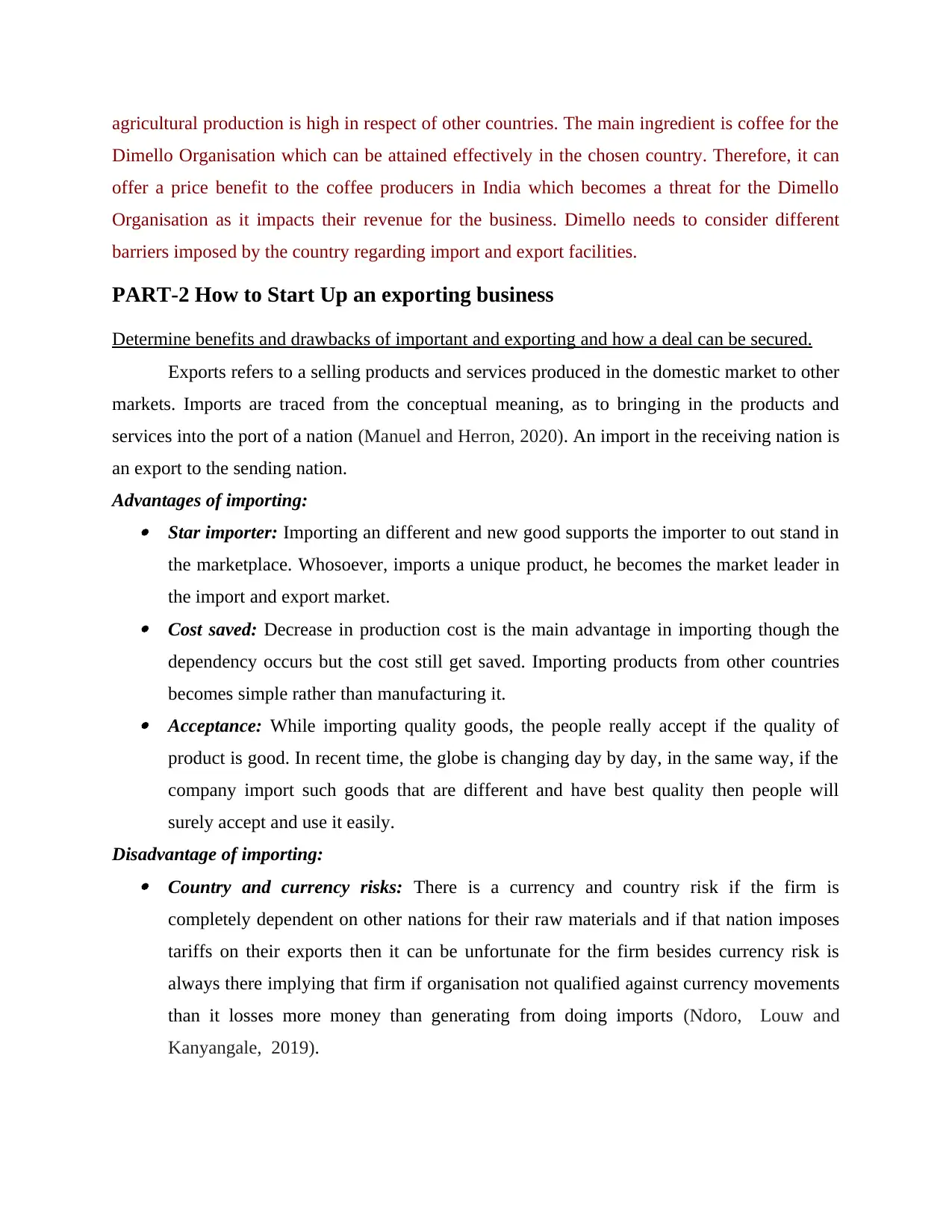
agricultural production is high in respect of other countries. The main ingredient is coffee for the
Dimello Organisation which can be attained effectively in the chosen country. Therefore, it can
offer a price benefit to the coffee producers in India which becomes a threat for the Dimello
Organisation as it impacts their revenue for the business. Dimello needs to consider different
barriers imposed by the country regarding import and export facilities.
PART-2 How to Start Up an exporting business
Determine benefits and drawbacks of important and exporting and how a deal can be secured.
Exports refers to a selling products and services produced in the domestic market to other
markets. Imports are traced from the conceptual meaning, as to bringing in the products and
services into the port of a nation (Manuel and Herron, 2020). An import in the receiving nation is
an export to the sending nation.
Advantages of importing: Star importer: Importing an different and new good supports the importer to out stand in
the marketplace. Whosoever, imports a unique product, he becomes the market leader in
the import and export market. Cost saved: Decrease in production cost is the main advantage in importing though the
dependency occurs but the cost still get saved. Importing products from other countries
becomes simple rather than manufacturing it. Acceptance: While importing quality goods, the people really accept if the quality of
product is good. In recent time, the globe is changing day by day, in the same way, if the
company import such goods that are different and have best quality then people will
surely accept and use it easily.
Disadvantage of importing: Country and currency risks: There is a currency and country risk if the firm is
completely dependent on other nations for their raw materials and if that nation imposes
tariffs on their exports then it can be unfortunate for the firm besides currency risk is
always there implying that firm if organisation not qualified against currency movements
than it losses more money than generating from doing imports (Ndoro, Louw and
Kanyangale, 2019).
Dimello Organisation which can be attained effectively in the chosen country. Therefore, it can
offer a price benefit to the coffee producers in India which becomes a threat for the Dimello
Organisation as it impacts their revenue for the business. Dimello needs to consider different
barriers imposed by the country regarding import and export facilities.
PART-2 How to Start Up an exporting business
Determine benefits and drawbacks of important and exporting and how a deal can be secured.
Exports refers to a selling products and services produced in the domestic market to other
markets. Imports are traced from the conceptual meaning, as to bringing in the products and
services into the port of a nation (Manuel and Herron, 2020). An import in the receiving nation is
an export to the sending nation.
Advantages of importing: Star importer: Importing an different and new good supports the importer to out stand in
the marketplace. Whosoever, imports a unique product, he becomes the market leader in
the import and export market. Cost saved: Decrease in production cost is the main advantage in importing though the
dependency occurs but the cost still get saved. Importing products from other countries
becomes simple rather than manufacturing it. Acceptance: While importing quality goods, the people really accept if the quality of
product is good. In recent time, the globe is changing day by day, in the same way, if the
company import such goods that are different and have best quality then people will
surely accept and use it easily.
Disadvantage of importing: Country and currency risks: There is a currency and country risk if the firm is
completely dependent on other nations for their raw materials and if that nation imposes
tariffs on their exports then it can be unfortunate for the firm besides currency risk is
always there implying that firm if organisation not qualified against currency movements
than it losses more money than generating from doing imports (Ndoro, Louw and
Kanyangale, 2019).

Domestic manufacturers are hit: When nation imports raw materials and other products
from other nations then local manufacturers and industries are hit as they import goods at
cheaper price than home products than lesser people will purchase local products and due
to less demand will result in the closure of the companies and industries as they cannot
keep occurring losses for long periods.
Advantages of exporting:
Opportunities: Whenever a new and unique product launches, it just catches the
attention of all the importers and entrepreneurs all over the global. In such times, the
chance to generate more revenue for the business gets higher and the exporting deals
turn very profitable. All suppose any importing nation has a every day product with
no alternative, it must be served with added values.
Build global recognition: When the nation export its goods, then the product are sell
to different nations and generate a global value to that good. The company gets global
recognition and people feel the firm more trustworthy. Hence, more people are
familiar with the service or good and the more profit can be generated.
Disadvantage of exporting:
Economic and political conditions: The political and economical conditions of the
importing nation may not remain the same every time as several things happen in the
economy and things keep changing (Orta, 2019). Hence, due to negative changes in the
importing nation, the exporting business severely affected.
Market information: Gathering information on some markets can be highly
complicated. Lack of information would means that company do not have enough
information on the competitors, markets and trends associated to certain products or
similar available products. This could be disadvantage in exporting goods in the taregt
market.
The above mentioned pros and cons of importing and exporting provides an illustration to
Dimello Company on how deals are secured and closed through trade process conclusion. The
process are as followed where negotiation happens between interested parties and after which the
deal has been secured. After the deal is secured the payment phase is the next step where prices
are united and after which the export and import activities take place by establishing channels of
distribution.
from other nations then local manufacturers and industries are hit as they import goods at
cheaper price than home products than lesser people will purchase local products and due
to less demand will result in the closure of the companies and industries as they cannot
keep occurring losses for long periods.
Advantages of exporting:
Opportunities: Whenever a new and unique product launches, it just catches the
attention of all the importers and entrepreneurs all over the global. In such times, the
chance to generate more revenue for the business gets higher and the exporting deals
turn very profitable. All suppose any importing nation has a every day product with
no alternative, it must be served with added values.
Build global recognition: When the nation export its goods, then the product are sell
to different nations and generate a global value to that good. The company gets global
recognition and people feel the firm more trustworthy. Hence, more people are
familiar with the service or good and the more profit can be generated.
Disadvantage of exporting:
Economic and political conditions: The political and economical conditions of the
importing nation may not remain the same every time as several things happen in the
economy and things keep changing (Orta, 2019). Hence, due to negative changes in the
importing nation, the exporting business severely affected.
Market information: Gathering information on some markets can be highly
complicated. Lack of information would means that company do not have enough
information on the competitors, markets and trends associated to certain products or
similar available products. This could be disadvantage in exporting goods in the taregt
market.
The above mentioned pros and cons of importing and exporting provides an illustration to
Dimello Company on how deals are secured and closed through trade process conclusion. The
process are as followed where negotiation happens between interested parties and after which the
deal has been secured. After the deal is secured the payment phase is the next step where prices
are united and after which the export and import activities take place by establishing channels of
distribution.
⊘ This is a preview!⊘
Do you want full access?
Subscribe today to unlock all pages.

Trusted by 1+ million students worldwide
1 out of 18
Related Documents
Your All-in-One AI-Powered Toolkit for Academic Success.
+13062052269
info@desklib.com
Available 24*7 on WhatsApp / Email
![[object Object]](/_next/static/media/star-bottom.7253800d.svg)
Unlock your academic potential
Copyright © 2020–2025 A2Z Services. All Rights Reserved. Developed and managed by ZUCOL.





